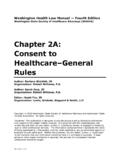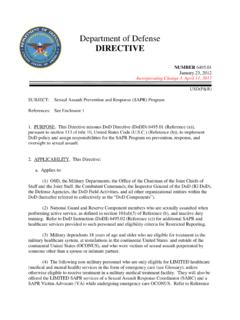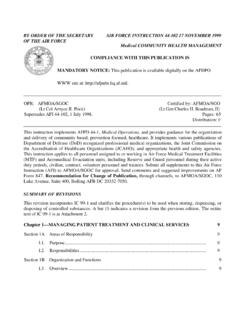Transcription of Identifying Healthcare-associated Infections (HAI) for ...
1 2-1 January 2018 Identifying Healthcare-associated Infections Identifying Healthcare-associated Infections (HAI) for NHSN Surveillance To standardize the classification of an infection as present on admission (POA) or a Healthcare-associated infection (HAI), the following objective surveillance definitions and guidance are used for NHSN surveillance: 7-day Infection Window Period (IWP) Date of Event (DOE) POA HAI 14-day Repeat Infection Timeframe (RIT) Secondary BSI Attribution Period (SBAP) Pathogen Assignment Guidance Location of Attribution (LOA) The intention of this approach is to align criteria and definitions and decrease subjectivity while maintaining epidemiologic standardization and clinical relevance.
2 A variety of scenarios to include repeat Infections of the same type, concurrent Infections of differing types, and pathogen assignment in multi-pathogen Infections are addressed. See Appendix Flow Diagram for NHSN Event Determination. General Instructions guidance found in this Chapter is not applicable when performing SSI, VAE orLabID surveillance. Infection window period, Date of Event, POA, HAI, and RIT,Secondary BSI Attribution Period definitions as defined in this chapter do not applyto SSI, VAE, or LabID Events (Table 1).Please refer to Chapters 9, 10 and 12 respectively for guidance specific to these eventdeterminations (Table 1). belonging to the following genera are typically causes of community- associated Infections and are rarely or are not known to be causes of Healthcare-associated Infections .
3 They are excluded, and cannot be used to meet any NHSN definition: Blastomyces, Histoplasma, Coccidioides, Paracoccidioides, Cryptococcusand Pneumocystis. Additionally refer to individual event protocols for pathogenexclusions specific to the event being reported, for example, BSI, UTI, PNEU,ENDO, GIT, and 2018 Identifying Healthcare-associated Infections If the date of specimen collection is on or after the date of documentation of evidence of consent AND the patient is being supported for organ donation purposes, an event identified using the specimen culture result or microbiologic non-culture based diagnostic test result should not be reported as an HAI. The patient should, however, still be included in device and patient day denominator data collection.
4 Patients are not excluded from NHSN of organisms from specimens collected during post-mortemexamination (autopsy) are only eligible for use in meeting the CNS/IC (Intracranial)infection definition and the PNEU infection definition using lung tissue specimenobtained by transthoracic or transbronchial biopsy immediately post-mortem. For allother NHSN definitions autopsy specimens/reports are not eligible for occurring in newborns with date of event on hospital day 1 or day 2 areconsidered POA. Those with date of event on day 3 or later are HAI. This includesinfections acquired transplacentally (for example but not limited to herpes simplex,toxoplasmosis, rubella, cytomegalovirus, or syphilis) or as a result from passagethrough the birth canal.
5 Exception: See guidance about non-reporting of CLABSI swith Group B Streptococcus during a neonate s first 6 days of life found in theComments and Reporting Instuctions section of the Bloodstream Infection Event(Central Line- associated Bloodstream Infection and Non-central line-associatedBloodstream Infection) of a latent infection (for example but not limited to herpes zoster[shingles], herpes simplex, syphilis, or tuberculosis) is not considered to be an 1: Exceptions to application of Chapter 2 SSI* LabID* VAE* Infection Window Period Not Applicable Not Applicable Not Applicable Date of Event POA HAI Repeat Infection Timeframe (RIT) Secondary BSI Attribution Period , See ENDO criteria in Chapter 17: CDC/NHSN Surveillance Definitions for Specific Types of Infections for endocarditis *See SSI, LabID and VAE surveillance protocolsN/A=Not Applicable- 2-3 January 2018 Identifying Healthcare-associated Infections Observation Patients in Inpatient Locations.
6 For purposes of NHSN surveillance, if an observation patient is admitted to an inpatient location, the patient must be included in all surveillance events designated in the monthly reporting plan and included in patient and device day counts. The patient is being housed, monitored, and cared for in an inpatient location and therefore is at risk for acquisition of an HAI. Infection Window Period: The Infection Window Period (IWP) is defined as the 7-days during which all site-specific infection criteria must be met. It includes the collection date of the first positive diagnostic test that is used as an element to meet the site-specific infection criterion, the 3 calendar days before and the 3 calendar days after (Table 2).
7 For purposes of defining the Infection Window Period the following examples are considered diagnostic tests: laboratory specimen collection imaging test procedure or exam Table 2: Infection Window Period Infection Window Period 3 days before Date of first positive diagnostic test that is used as an element of the site-specific criterion OR In the absence of a diagnostic test, use the date of the first documented localized sign or symptom that is used as an element of the site-specific criterion 3 days after It is important to use the first diagnostic test that creates an infection window period during which all elements of the criterion can be found. See example below. Example When meeting PNEU definition using the PNU2 criterion, identification of an eligible organism from blood or from a site-specific specimen, and an imaging test may be available.
8 Both the organism identification and the imaging test are diagnostic tests. Use the first 2-4 January 2018 Identifying Healthcare-associated Infections diagnostic test for which all elements of the PNU2 criterion occur within the infection window period. In this example below, Option 1 uses the imaging test (not the blood culture) to set the infection window period. This is the first diagnostic test that creates an infection window period in which all elements of PNU2 criterion occur. Option 1: Correct diagnostic test selection Hospital Day Infection Window Period -2 -1 1 2 POA New onset cough 3 Imaging test: Infiltrate 4 Fever > C 5 Fever > C 6 Blood culture: A. baumannii 7 Rales, Fever > C 8 Cough, Rales 9 10 11 12 13 14 15 16 17 Option 2: Incorrect diagnostic test selection Hospital Day Infection Window Period -2 -1 1 2 New onset cough 3 HAI Imaging test: Infiltrate 4 Fever > C 5 Fever > C 6 Blood culture: A.
9 Baumannii 7 Rales, Fever > C 8 Cough, Rales 9 10 11 12 13 14 15 16 17 Infection Window Period Special Considerations 1. Infection criteria that do not include a diagnostic test: For site-specific infection criteria that do not include a diagnostic test, the date of the first documented localized sign or symptom that is used as an element of the site-specific infection criterion is used to define the infection window period for example, 2-5 January 2018 Identifying Healthcare-associated Infections diarrhea, site-specific pain, purulent drainage. Note that a non-specific sign or symptom for example, fever is not considered to be localized and therefore is not to be used to define the infection window period.
10 For example, when meeting EMET using criterion 2, there is no diagnostic test as a part of this criterion. The date of the first documented localized sign or symptom, purulent drainage or pain or tenderness that is used as an element to meet EMET criterion 2 is to be used to set the infection window period. Fever is not a localized sign. 2. More than one criterion can be met: When more than one criterion of a site-specific infection definition is met, identify the infection window period that results in the earliest date of event. Example A patient has purulent drainage noted at a superficial wound site on hospital day 2. It is documented on day 3 that the wound site is painful and swelling is present.














